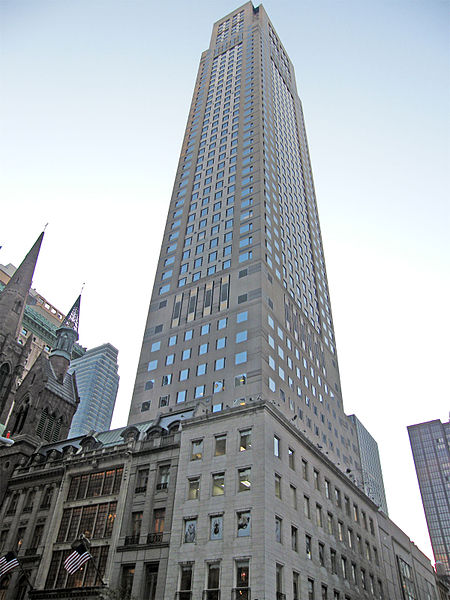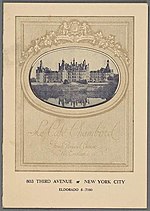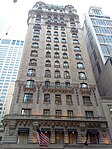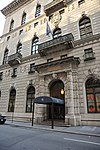712 Fifth Avenue

712 Fifth Avenue is a 650-foot-tall (200 m) skyscraper at 56th Street and Fifth Avenue in the Midtown Manhattan neighborhood of New York City. Constructed from 1987 to 1990, it was designed by SLCE Architects and Kohn Pedersen Fox Associates. The skyscraper's base includes the Coty Building at 714 Fifth Avenue (built 1871) and the Rizzoli Bookstore building at 712 Fifth Avenue (built 1908), both of which are New York City designated landmarks. The facades of the Coty and Rizzoli buildings are preserved at the base; an imitation facade was also built at 716 Fifth Avenue to complement the grouping. The lower floors contain a storefront and an atrium behind the landmark facades of the Coty and Rizzoli buildings. The tower stories contain a facade of white marble, gray limestone, and green and black granite. Inside the tower, each floor has 7,500 square feet (700 m2) of office space on average. The newer tower's juxtaposition with the Coty and Rizzoli buildings was both praised and criticized by architectural writers such as Paul Goldberger and Christopher Gray. Before the construction of the present skyscraper, 712 Fifth Avenue was the address of the Rizzoli Bookstore building. Planning for 712 Fifth Avenue dates to 1983, but the project was delayed for several years because of opposition to the demolition of historic structures at the skyscraper's base. The Coty and Rizzoli buildings were incorporated into the base, where a Henri Bendel store operated from 1990 until 2018. Upon completion, the skyscraper was mostly vacant because of a weak real-estate market. The building was sold in 1999 to the Paramount Group for a then-record $285 million.
Excerpt from the Wikipedia article 712 Fifth Avenue (License: CC BY-SA 3.0, Authors, Images).712 Fifth Avenue
5th Avenue, New York Manhattan
Geographical coordinates (GPS) Address External links Nearby Places Show on map
Geographical coordinates (GPS)
| Latitude | Longitude |
|---|---|
| N 40.7622 ° | E -73.975 ° |
Address
712 Fifth Avenue
5th Avenue 712
10019 New York, Manhattan
New York, United States
Open on Google Maps








